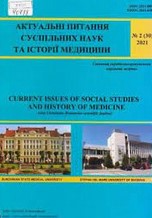ЕКФРАЗИС ТВОРІВ ЖИВОПИСУ В РОМАНІ П. ЗАГРЕБЕЛЬНОГО “ДИВО”
EKPHRASIS OF PAINTING IN P. ZAHREBELNY'S NOVEL “WONDER”
Author(s): Natalia BilykSubject(s): Visual Arts, Semantics, Ukrainian Literature, Theory of Literature
Published by: Видавництво ВДНЗ України « Буковинський державний медичний університет »
Keywords: ekphrasis; painting; semantics; P. Zahrebelny; “Wonder”;
Summary/Abstract: At the modern stage, ekphrasis was recognized as one of the most fruitful and effective phenomena for comparativistics – the manifestation of specific expressive mediation of one medium in the figurative field of another. Bright, contrasting manifestations of ekphrasis are observed in the content of the novel “Wonder” by the classic of Ukrainian literature P. Zahrebelny. They focus on painting and the work of artists, contain prognostic features of the current semantic potential, and thereby determine the relevance of their coverage. The purpose of the study, therefore, is to distinguish the features of ekphrasis of works of painting, as well as to highlight the formal and semantic dominants and the overall semantic configuration of the expressed poetics of the phenomenon of painting in prose. The novelty consists in the identification, poetic classification, semantic analysis and final systematization of figurative instances of literary prose, which descriptively reveal the expressive means of painting with the generalization of their semantic panorama within the boundaries of a localized description and on the scale of the novel in general, in particular, in relation to landmarks from the field of axiology, as well as with functional weighting in accordance with the definitive signs of literary imagology, which enriches the experience of the ethno-image-creating fruitfulness of the ekphrasis of painting. The study is based on the methods of cultural semiotic and structural-semantic analysis in combination with a descriptive and comparative-typological approach. Conclusions. As a result, it was found that the features of the ekphrasis of painting in “Wonder” testify to a separate experience of a multifaceted ekphrastic model. According to its formal dominants, in compliance with the criteria of the medium and the structure of the image, a condensed discrete ekphrasis is distinguished. In its plot-fabula track, the figurative material that turns out to be the carrier of ekphrastic poetics, the focus on the figure of the common heroine stands out. Its semantic accents emphasize the stages of its spiritual impoverishment and decline and, at the same time, the tragedy of the lack of spirituality, in particular, for creativity. Meanwhile in the heroine, the creation of a semantically multi-dimensional image is observed through the richness of ekphrases: in the combined form-meaning transitions of ekphrasis, the meaning-making line builds up and reaches the sphere of ethnoimagology, for which the basis of identity should be recognized as a full-scale verification of purely artistic meanings and senses. It is about the ability to clarify the idea of striving to avoid negative human qualities, to overcome or compensate for them, in particular, through the power of art, through the prism of the revealed precedent of Russian mental apathy.
Journal: Актуальні питання суспільних наук та історії медицини
- Issue Year: 2022
- Issue No: 2
- Page Range: 99-103
- Page Count: 5
- Language: Ukrainian

